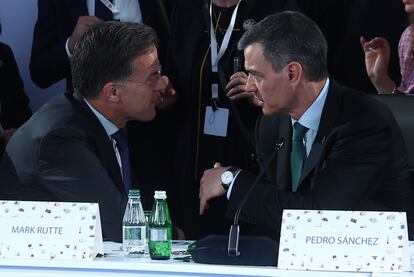Spain threatens to block NATO’s 5% defense spending target
Ahead of a key summit in The Hague next week, Secretary General Mark Rutte sent a letter to alliance members setting out the new spending threshold, which mirrors Trump’s demands

There are thunderclouds hanging over the most important NATO summit since the Cold War, to be held in just a few days in The Hague. NATO Secretary General Mark Rutte on Wednesday sent a letter to the members of the Alliance that included all of Donald Trump’s wishes: NATO partners must increase spending on security and defense to 5% of gross domestic product (GDP), a figure currently not reached by any of the allies, not even the United States.
In Spain, this would mean increasing defense spending by €80 billion a year, almost half of what the state spends on pensions. Several countries could block this agreement, which must be adopted unanimously. And Spain, said sources at La Moncloa Palace, the seat of government, is one of them.
Spanish Prime Minister Pedro Sánchez, of the Socialist Party (PSOE)‚ has sent a letter back to Rutte, to which EL PAÍS has had access, in which he warns that, “for Spain, committing to a 5% target would not only be unreasonable, but also counterproductive; it would move Spain away from optimal spending and would hinder the EU’s efforts to strengthen its security and defense ecosystem.”
Sources at La Moncloa said they do not rule out the possibility that Europe will one day reach defense spending of 5% in the face of Russia’s expansionist militarization, but they consider it premature to set such a goal now.
The request comes a time when the situation in the Middle East has reached new levels of tension with the crossfire between Israel and Iran; meanwhile, the war in Ukraine is well on the way to becoming entrenched in Europe, which is in turn being forced to learn to defend itself alone in the face of constant threats from Trump.
Rutte’s request anticipates a tense situation in The Hague, where a handful of countries — not just Spain — oppose such a significant leap: the current spending threshold is 2% of GDP. The Dutch city is rolling out tight security measures ahead of the June 24-25 gathering, which is scheduled to feature leaders of the 32-nation alliance, including the U.S. president.
After French president Emmanuel Macron declared NATO “brain dead” a few years ago, Russia’s Vladimir Putin revived the alliance with his 2014 attack on the Crimea peninsula and, above all, with the invasion of the Donbas region of Ukraine in 2022. Trump is demanding for Europe to take a step forward, and for European Union partners to become producers rather than just consumers of security. But within the EU-27, sensitivities are very different: in Central and Eastern Europe, from the Baltics to Poland and the Nordic countries, fear of Russia has set off alarm bells, while in countries further away like Italy, Portugal, and Spain, the sense of danger is very different, and the focus remains on the Mediterranean, immigration, and other issues.
The United States has been pushing for a 5% GDP spending target for months, with Rutte (a supposedly “frugal” figure in terms of fiscal policy) morphing into a Trumpist figurehead. But the division within the alliance has been evident from the outset: some countries emphasize that the goal should not be a fixed percentage, but rather the fulfillment of the established objectives and capabilities. These countries prefer including other expenditure items in the final percentage: 3.5% for purely military spending, and the remaining 1.5% for issues related to cybersecurity, infrastructure, and related matters.
Sign up for our weekly newsletter to get more English-language news coverage from EL PAÍS USA Edition
Tu suscripción se está usando en otro dispositivo
¿Quieres añadir otro usuario a tu suscripción?
Si continúas leyendo en este dispositivo, no se podrá leer en el otro.
FlechaTu suscripción se está usando en otro dispositivo y solo puedes acceder a EL PAÍS desde un dispositivo a la vez.
Si quieres compartir tu cuenta, cambia tu suscripción a la modalidad Premium, así podrás añadir otro usuario. Cada uno accederá con su propia cuenta de email, lo que os permitirá personalizar vuestra experiencia en EL PAÍS.
¿Tienes una suscripción de empresa? Accede aquí para contratar más cuentas.
En el caso de no saber quién está usando tu cuenta, te recomendamos cambiar tu contraseña aquí.
Si decides continuar compartiendo tu cuenta, este mensaje se mostrará en tu dispositivo y en el de la otra persona que está usando tu cuenta de forma indefinida, afectando a tu experiencia de lectura. Puedes consultar aquí los términos y condiciones de la suscripción digital.
More information
Archived In
Últimas noticias
Most viewed
- Alain Aspect, Nobel laureate in physics: ‘Einstein was so smart that he would have had to recognize quantum entanglement’
- Maps of the US attack on Venezuela: Targets, airspace and deployed fleet
- Key points of the military attack on Venezuela: Early morning bombings and a ‘captured’ president
- Oil, gold and rare earth elements: the backdrop to US political tension with Venezuela
- The US bombing of Venezuela, in pictures










































